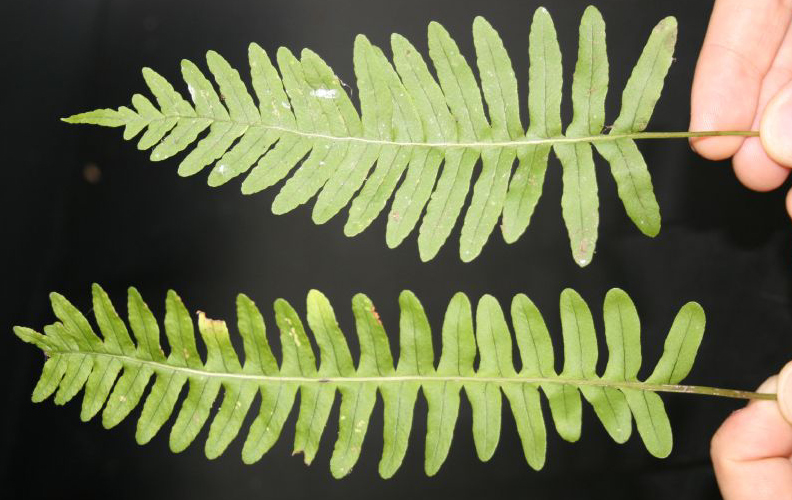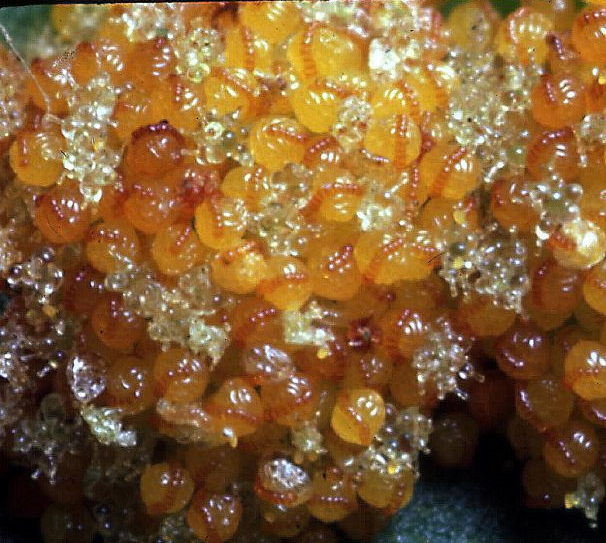| Polypodium appalachianum | ||
Appalachian polypody | ||
|
Etymology
Appalachianum is the Latinization of Appalachian, describing a region of the Eastern US.
Description
Rhizome: creeping, branching, whitish pruinose, slender, to 6 mm diam., scales lanceolate, mostly uniformly golden brown.
Frond: 35 cm high by 12 cm wide, evergreen, monomorphic, blade/stipe ratio: 1:1 or a little more. Stipe: jointed at base, straw-colored, glabrous or scattered with thin light-brown scales, vascular bundles: 3. Blade: pinnatifid, oblong to narrowly lanceolate, usually widest near the near base, leathery, rachis sparsely scaly below, glabrous above; scales lanceolate-ovate. Pinnae: linear, entire to slightly dentate, broadest near the base, apex more pointed than virginicum, at least near the base of the the blade; veins free. Sori: round, discrete, midway between margin and midrib to nearly marginal; on all but the lowest pinnae of fertile fronds, indusium: absent, sporangia: yellow then brown at maturity; paraphyses (branching structures among the sporangia) present, maturity: summer to fall. Culture
Habitat: cliffs and rocky slopes; on a variety of substrates.
Distribution: eastern North America.
Hardy to -35�C, USDA Zone 3.
Distinctive Characteristics
Distinguished from P. virginianum by being broader near the
base of the blade and stipe scales all golden brown, not bicolored. No
images of the scales could be found. Nonetheless, there is a good deal
of variation, and the taxonomist falls back on spore size and
chromosome counts.
Synonyms
Polypodium virginianum misapplied Compare with other species in the Eastern North America Group
|
|
|
Notes
Compare to Polypodium appalachianum, above, and P. virginianum, below.Three characters differ: pinnules pointed on P. appalachianum, pinnules rounded on P. virginianum; blade triangular, widest near base with P. appalachianum, blade with more parallel sides, often widest at the middle, for P. virginianum; lowermost pinnule meets rachis creating a distinct notch in P. appalacianum, hard to see here, but click through to the original, somewhat clearer. The apex of lower frond is aberrant.
Compare to Polypodium appalachianum, above, and P. virginianum, below.Three characters differ: pinnules pointed on P. appalachianum, pinnules rounded on P. virginianum; blade triangular, widest near base with P. appalachianum, blade with more parallel sides, often widest at the middle, for P. virginianum; lowermost pinnule meets rachis creating a distinct notch in P. appalacianum, hard to see here, but click through to the original, somewhat clearer. The apex of lower frond is aberrant.

Polypodium appalachianum above and P. virginianum below. See the note for an explanation. �Robbin Moran |

Polypodium appalachianum. Paraphyses, the translucent, branched structures among the sporangia. Here under the microscope, but you can see these with the hand lens. �Robbin Moran |
